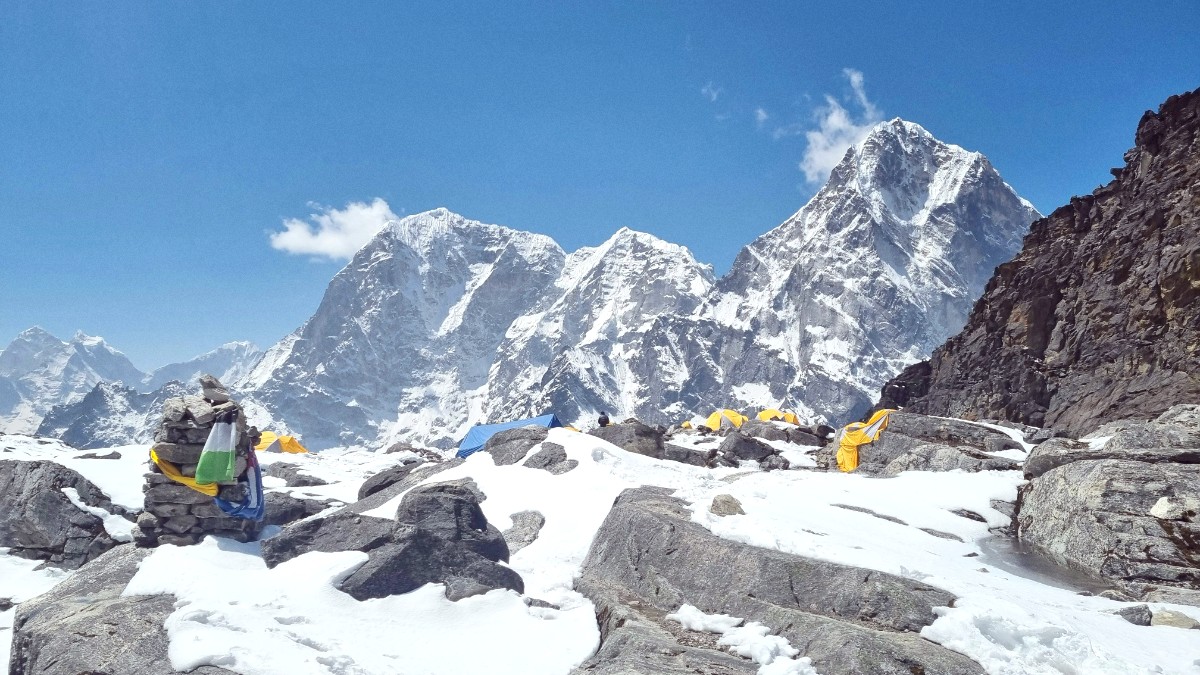
Nepal
For centuries, mountain communities relied on simple, nutritious ingredients that run on harsh climates and long transportation. Food is often milder than Indian dishes, with staple grains and vegetables, supplemented by local meat (buffalo or yak at lower altitudes, less common higher up).
Dining is often communal, a reflection of the close-knit mountain communities and teahouse culture. Common ingredients include rice, lentils (dal), potatoes, spinach, cauliflower, cabbage, and other seasonal vegetables. Wheat and corn are used for bread and porridge. Spices are moderate, focusing on cumin, coriander, turmeric, ginger, garlic, and a touch of chili. Yak cheese is a delicacy in higher villages.
While Dal Bhat is universally available, preparation and menu items vary slightly with altitude. Higher up, menus restrict to basic items like rice, noodles, and potatoes due to transport costs. Meat options become rare or not recommended.
On the trek, breakfast is early (around 6-7 AM) before your day's walk. Lunch is typically mid-day at a teahouse. Dinner is served in the teahouse dining hall, usually 6-8 PM, for warmth and socializing.
Nepal's national dish. Steamed rice, hearty lentil soup (dal), vegetable curry (tarkari), often with pickle (achar).
Often includes free refills of rice and dal, offering unlimited carbohydrates and protein. It is economical, nutritious, and safe.
Nepali dumplings, similar to Tibetan momos. Typically steamed or fried, filled with finely chopped vegetables (veg momo), minced chicken (chicken momo), or sometimes buffalo meat (buff momo) at lower altitudes.
Served with a spicy dipping sauce.
A warming and hearty Tibetan noodle soup. It has vegetables and sometimes meat (chicken or yak, typically at lower altitudes where meat is reliably fresh).
It is a comforting and hydrating choice, especially in the cold.
Widely available. Locals consider garlic helpful for altitude adaptation, though scientific evidence is limited. It is a warming and flavorful soup.
Milk Tea, Ginger Lemon Honey Tea (soothing for sore throats), Hot Chocolate (a popular evening treat), Black Tea/Coffee are available for hydration and warmth.
These are the main dining establishments on the trek. Every teahouse includes a communal dining hall where meals are cooked fresh from the teahouse kitchen.
Bakeries are mainly found in Namche Bazaar. These establishments offer fresh-baked goods like apple pie, cinnamon rolls, cookies, and various pastries.
Teahouse menus mainly focus on energy-rich, easy-to-prepare dishes that cater to trekkers' needs.
The EBC trek is very friendly to vegetarians and vegans. Dal Bhat is typically vegetarian (and can be vegan if you request no ghee/butter). Many noodle dishes, potato dishes, and vegetable curries are naturally meat-free.
When ordering, clearly state "no meat" (masu chaina) or "vegetarian" (shakahari). Vegan travelers should specify "no milk" (dudh chaina) and "no butter/ghee" (ghyu chaina).
Halal or Kosher specific options are generally not available in teahouses. Meat available on the trek is generally not halal/kosher certified.
Vegetarian options remain the best choice for travelers with these dietary needs.
Rice-based dishes like Dal Bhat are naturally gluten-free. Noodle dishes and Tibetan bread contain gluten.
For severe allergies, communication can be difficult. Carry an allergy card translated into Nepali.
Relying on boiled water and simple, well-cooked vegetable and rice dishes is generally the safest for sensitive stomachs or allergies.
Consider packing specific snacks or dietary supplements if your needs are very strict.
Not available on the EBC trek itself. In Kathmandu, cooking classes teach traditional Nepali dishes like Dal Bhat or Momos.
This can be a pre-trek activity.
Not relevant to the remote trekking route. Major food festivals occur in Kathmandu during specific cultural events.
Check local Kathmandu listings.
Evenings in teahouses revolve around the communal dining hall, providing a warm space to relax after trekking. Trekkers play cards, read, or chat.
Enjoying a hot drink and pastry with views of the Himalayas from a bakery is a simple pleasure. The availability of fresh baked goods at such elevations is unique.
The simple, fresh preparation of local ingredients is a highlight of teahouse meals, designed to fuel your journey.
The "Everest Bakery" in Namche Bazaar and higher altitude bakeries are unique for serving fresh baked goods at elevation.
Dining in teahouse halls with other trekkers offers opportunities to share stories and learn about different cultures.
Communicating dietary needs is important, though it can present a challenge due to language barriers in remote areas.
Consider carrying an allergy card translated into Nepali.
Always inquire about ingredients, but know that cross-contamination can occur in small kitchens. Simplicity in food choices can reduce risks.
Boiled water and well-cooked dishes are often the safest.
Early meals before starting the day's walk. Options include Tibetan bread, porridge, eggs, or chapati.
Typically eaten at a teahouse along the trail, often Dal Bhat or noodles. Choose a warm spot.
Served in the teahouse dining hall, it is a time for warmth, food, and socializing with fellow trekkers.
Always carry easy-to-digest snacks like energy bars, chocolates, or dried fruit in your daypack. These provide quick energy boosts between teahouses and supplement meals, especially if you have specific dietary needs or preferences.